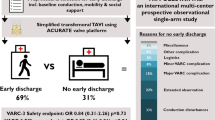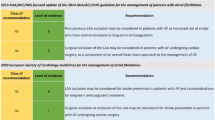Abstract
Purpose
We aimed to evaluate the late clinical outcomes of percutaneous LAA closure in patients with atrial fibrillation (AF) and contraindication to oral anticoagulation.
Methods
Consecutive AF patients with contraindications to oral anticoagulation who underwent successful LAA closure between December 2008 and March 2013 at four centers were included.
Results
A total of 101 patients (median age 76 [IQR 69–80] years, 48% women, mean CHA2DS2-VASc 5 ± 2; HAS-BLED 4 ± 1) were included. Eighty-six (85.1%) patients received an Amplatzer Cardiac Plug/Amulet device and 15 (14.9%) patients a Watchman device. The mean follow-up period was 4 ± 1 years. During 358.6 patient-years of follow-up, 7 (6.9%) patients suffered a major stroke (2 cases per 100 person-years; expected rate: 6.2 cases per 100 person-years), and 20 (19.8%) patients experienced at least one episode of major bleeding (6.4 cases per 100 person-years; expected rate: 9.0 cases per 100 person-years). There were no cases of late adverse events related to the device. A total of 34 (33.7%) patients died during follow-up (9.5 cases per 100 person-years). Older age, male sex, low ejection fraction, and chronic kidney disease were identified as predictive factors of late mortality.
Conclusions
Percutaneous LAA closure is safe and effective in the long term in patients with AF with contraindications to anticoagulation. However, a high long-term mortality rate was observed in this high-risk population. Comprehensive patient assessment prior to undergoing LAA closure should identify patients in whose comorbidities limit their overall prognosis.


Similar content being viewed by others
References
Schnabel RB, Yin X, Gona P, Larson MG, Beiser AS, McManus DD, et al. 50 year trends in atrial fibrillation prevalence, incidence, risk factors, and mortality in the Framingham Heart Study: a cohort study. Lancet. 2015;386:154–62.
Miyasaka Y, Barnes ME, Gersh BJ, Cha SS, Bailey KR, Abhayaratna WP, et al. Secular trends in incidence of atrial fibrillation in Olmsted County, Minnesota, 1980 to 2000, and implications on the projections for future prevalence. Circulation. 2006;114:119–25.
Verheugt FWA, Granger CB. Oral anticoagulants for stroke prevention in atrial fibrillation: current status, special situations, and unmet needs. Lancet. 2015;386:303–10.
Reddy VY, Sievert H, Halperin J, Doshi SK, Buchbinder M, Neuzil P, et al. Percutaneous left atrial appendage closure vs warfarin for atrial fibrillation: a randomized clinical trial. JAMA. 2014;312:1988–98.
Holmes DR, Doshi SK, Kar S, et al. Left atrial appendage closure as an alternative to warfarin for stroke prevention in atrial fibrillation. J Am Coll Cardiol. 2015;65:2614–23.
Tzikas A, Shakir S, Gafoor S, Omran H, Berti S, Santoro G, et al. Left atrial appendage occlusion for stroke prevention in atrial fibrillation: multicentre experience with the AMPLATZER Cardiac Plug. EuroIntervention. 2016;11:1170–9.
Urena M, Rodés-Cabau J, Freixa X, Saw J, Webb JG, Freeman M, et al. Percutaneous left atrial appendage closure with the AMPLATZER cardiac plug device in patients with nonvalvular atrial fibrillation and contraindications to anticoagulation therapy. J Am Coll Cardiol. 2013;62:96–102.
Reddy VY, Möbius-Winkler S, Miller MA, Neuzil P, Schuler G, Wiebe J, et al. Left atrial appendage closure with the watchman device in patients with a contraindication for oral anticoagulation. J Am Coll Cardiol. 2013;61:2551–6.
Reddy VY, Doschi SK, Kar S. 5-Year outcomes after left atrial appendage closure: from the PREVAIL and PROTECT AF trials. J Am Coll Cardiol. 2017;70:2964–75.
Block PC, Burstein S, Casale PN, Kramer PH, Teirstein P, Williams DO, et al. Percutaneous left atrial appendage occlusion for patients in atrial fibrillation suboptimal for warfarin therapy: 5-year results of the PLAATO (Percutaneous Left Atrial Appendage Transcatheter Occlusion) study. JACC Cardiovasc Interv. 2009;2:594–600.
Sharma D, Reddy V, Sandri M, et al. Left atrial appendage closure in patients with contraindications to oral anticoagulation. J Am Coll Cardiol. 2016;67:2190–2.
Tzikas A, Homes DR, Gafoor S, et al. Percutaneous left atrial appendage occlusion: the Munich consensus document on definitions, endpoints, and data collection requirements for clinical studies. EuroIntervention. 2016;12:103–11.
Aminian A, Lalmand J, Tzikas A, Budts W, Benit E, Kefer J. Embolization of left atrial appendage closure devices: a systematic review of cases reported with the watchman device and the amplatzer cardiac plug. Catheter Cardiovasc Interv. 2015;86:128–35.
Schroeter MR, Danner BC, Hünlich M, Schillinger W. Uncommon delayed and late complications after percutaneous left atrial appendage closure with Amplatzer(®) Cardiac Plug. Clin Res Cardiol. 2014;103:285–90.
Main ML, Fan D, Reddy VY, Holmes DR, Gordon NT, Coggins TR, et al. Assessment of device-related thrombus and associated clinical outcomes with the WATCHMAN left atrial appendage closure device for embolic protection in patients with atrial fibrillation (from the PROTECT-AF trial). Am J Cardiol. 2016;117:1127–34.
Nietlispach F, Gloekler S, Krause R, Shakir S, Schmid M, Khattab AA, et al. Amplatzer left atrial appendage occlusion: single center 10-year experience. Catheter Cardiovasc Interv. 2013;82:283–9.
Park J-W, Bethencourt A, Sievert H, Santoro G, Meier B, Walsh K, et al. Left atrial appendage closure with Amplatzer cardiac plug in atrial fibrillation: initial European experience. Catheter Cardiovasc Interv. 2011;77:700–6.
Mauri L, Kereiakes DJ, Yeh RW, Driscoll-Shempp P, Cutlip DE, Steg PG, et al. Twelve or 30 months of dual antiplatelet therapy after drug-eluting stents. N Engl J Med. 2014;371:2155–66.
Gandhi S, Schwalm J-DR, Velianou JL, Natarajan MK, Farkouh ME. Comparison of dual-antiplatelet therapy to mono-antiplatelet therapy after transcatheter aortic valve implantation: systematic review and meta-analysis. Can J Cardiol. 2015;31:775–84.
Yeh RW, Secemsky EA, Kereiakes DJ, Normand SLT, Gershlick AH, Cohen DJ, et al. Development and validation of a prediction rule for benefit and harm of dual antiplatelet therapy beyond 1 year after percutaneous coronary intervention. JAMA. 2016;315:1735–49.
Rodriguez-Gabella T, Nombela-Franco L, Regueiro A, Jiménez-Quevedo P, Champagne J, O’Hara G, et al. Single antiplatelet therapy following left atrial appendage closure in patients with contraindication to anticoagulation. J Am Coll Cardiol. 2016;68:1920–1.
Kim YD, Cha MJ, Kim J, Lee DH, Lee HS, Nam CM, et al. Ischaemic cardiovascular mortality in patients with non-valvular atrial fibrillation according to CHADS2 score. Thromb Haemost. 2011;105:712–20.
Castilla E, Morillas P, Gómez M, Ahumada M, Monteagudo M, Fácila L, et al. Use of the CHADS2 score as predictor of the risk of mortality in hypertensive patients. The FAPRES study. Med Clin (Barc). 2016;146:478–83.
Paoletti Perini A, Bartolini S, Pieragnoli P, Ricciardi G, Perrotta L, Valleggi A, et al. CHADS2 and CHA2DS2-VASc scores to predict morbidity and mortality in heart failure patients candidates to cardiac resynchronization therapy. Europace. 2014;16:71–80.
Reddy VY, Akehurst RL, Armstrong SO, Amorosi SL, Brereton N, Hertz DS, et al. Cost effectiveness of left atrial appendage closure with the Watchman device for atrial fibrillation patients with absolute contraindications to warfarin. Europace. 2016;18:979–86.
Funding
Ander Regueiro and Tania Rodriguez-Gabella were supported by a grant from the Fundacion Alfonso Martin Escudero, Madrid, Spain. Josep Rodés-Cabau holds the Canadian Research Chair “Famille Jacques Larivière” for the Development of Structural Heart Disease Interventions.
Author information
Authors and Affiliations
Corresponding author
Ethics declarations
Conflict of interest
Dr. Ignacio Cruz-Gonzalez is proctor and consultant for St. Jude Medical and Boston Scientific. All other authors declare that they have no conflicts of interest.
Ethical approval
All procedures were performed in accordance with the local ethics committee of each center.
Informed consent
All patients gave written informed consent before the procedure(s).
Rights and permissions
About this article
Cite this article
Regueiro, A., Cruz-Gonzalez, I., Bethencourt, A. et al. Long-term outcomes following percutaneous left atrial appendage closure in patients with atrial fibrillation and contraindications to anticoagulation. J Interv Card Electrophysiol 52, 53–59 (2018). https://doi.org/10.1007/s10840-018-0356-9
Received:
Accepted:
Published:
Issue Date:
DOI: https://doi.org/10.1007/s10840-018-0356-9




